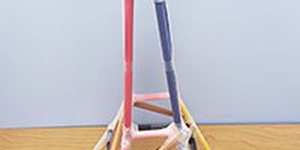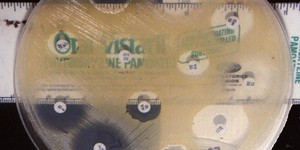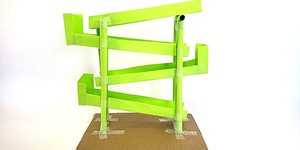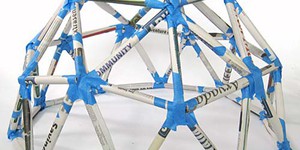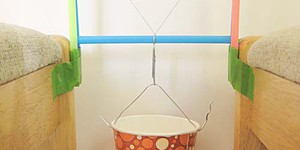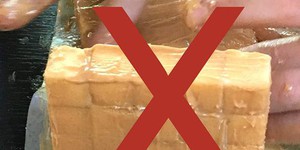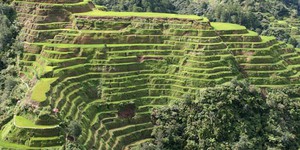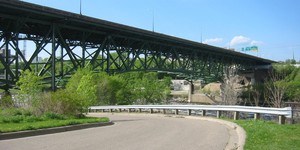Middle School, Civil Engineering Science Projects (21 results)
Civil engineering is a field for problem solvers. From setting up water systems for drinking and irrigation to major transportation systems like highways, airports, subways, and railroads, civil engineers take on big challenges. In today's world, civil engineers also face big challenges: providing the modern infrastructure for a growing human population, and finding ways to do this that are environmentally sound, safe, and cost-effective. Experience what it is like, on a smaller scale, to tackle these problems.
|
Select a resource
Sort by
|
In this engineering challenge, you will use limited materials to build a paper tower as tall as possible, but there's a twist! Your tower must also support a heavy weight at the top without collapsing. Looking for inspiration? You can see how other students have tackled this and other annual Science Buddies Engineering Challenges.
Teachers, lesson plan versions of this challenge are also available.
Read more
Featured
Have you heard that garlic powder is supposed to inhibit the growth of bacteria? Which do you think would make a better disinfectant: a solution of garlic powder or a solution of bleach? This project shows you a straightforward way to compare the effectiveness of different disinfectants (or other antimicrobial agents), by measuring zones of inhibition on a culture plate.
Read more
In this engineering challenge, you will build a ball run from paper and tape, but there's a twist! You want to make your ball run as slow as possible. How long can you make it take for the ball to get from the entrance to the exit? You can see how other students have tackled this and other annual Science Buddies Engineering Challenges.
Read more
New
Does your dog get bored when you are not home? Do you ever toss them a few treats right before you head out the door? What if you could keep them busy by automatically dispensing treats throughout the day? What about training them to sit in a certain place or even press a button by automatically rewarding them with treats? In this project you will build your own automatic dog (or cat, or other pet) treat dispenser that you can customize to react to different sensors.
Read more
Build model bridges and then deliberately destroy them? Who'd be crazy enough to try that?
Read more
Have you ever seen a geodesic dome? Geodesic domes are approximately sphere-like (or partially sphere-like) structures made up of interconnected triangles. A famous geodesic dome is Spaceship Earth at EPCOT in Walt Disney World, Florida, but geodesic domes are also commonly found as climbing domes at playgrounds. In this science project, you will get to build a geodesic dome using rolled-up newspapers and tape. How much mass do you think your dome will be able to support? Build one and find out!
Read more
This is an interesting project that explores which geometrical shapes make the strongest bridge truss structures. It is a good introduction to the engineering design process. You'll design three different trusses, and use online simulation software to analyze the distribution of load-bearing forces in each design. Then you'll build and test prototypes of each design.
Read more
New
If someone asks you to draw a picture of a doctor, lawyer, or engineer, what first pops into your mind? The race and gender of the person you imagine might be shaped by your personal life experiences, such as whether you have family members in those professions, or what representations of them you have seen on TV or online. What do you think will happen if you ask an artificial intelligence (AI) program to generate the picture instead? Will pictures generated by AI reflect the true real-world…
Read more
Suspension bridges, with their tall towers, long spans, and gracefully curving cables, are beautiful examples of the work of civil engineers. How do the cables and towers carry the load that is on the bridge? Can a suspension bridge carry a greater load than a simple beam bridge? This science project shows you how to find out.
Read more
Have you ever been in an earthquake? What did it feel like? Did you jiggle back and forth? Up and down? Was there a jolt? Or a rolling motion? Come build a house Hansel and Gretel would love to eat, a special table to shake it on, and see how different soil types can amplify shaking.
Read more
This project is inspired by the Banaue Rice Terraces, 2,000 year old structures carved into mountainsides in the Philippines. See if you can recreate the water flow of this ancient marvel, often called the Eighth Wonder of the World, using just household materials! Looking for inspiration? You can see how other students have tackled this and other annual Science Buddies Engineering Challenges.
Read more
A bridge collapse, like that of the I-35W Mississippi River Bridge, can be a major disaster. Bridges that cannot hold enough weight to do their intended job can be a serious public safety issue. And if they collapse, they can also cause economic damage due to costly rebuilding and people and companies scrambling to figure out how to circumvent the months of traffic impacts.
Figure 1.
On August 1, 2007 the I-35W Mississippi River Bridge collapsed killing 13…
Read more
Using just a single sheet of paper (8.5 x 11 inches) and up to five paper clips, can you build a bridge that will span 20 cm and support the weight of 100 pennies? The area beneath the span must be free (so that boats can pass beneath it). To test your bridge, place two books 20 cm apart, and set the bridge on the books, spanning the gap. Do not fasten the bridge to the book (nor to any other support). Does your bridge hold as much weight as you expected it would? If your bridge fails…
Read more
|
Explore Our Science Videos
Squishy Circuits Classroom Activity Part 1
How to Make a Bristlebot
Reaction Rates: When Surface Area Matters! Lesson Plan Introduction

